Looking for something to cast a tropical spell over your garden? Look no further than the fantastic frangipani. Frangipani belongs to a species called Plumeria and produces a wide range of brightly coloured, perfumed flowers that bloom throughout the summer.
This tropical tree is perfect to suit any style of garden and is perfectly suited to the Australian climate. Easy to propagate, easy to grow. Here is everything you need to know about growing frangipani tree.
More...
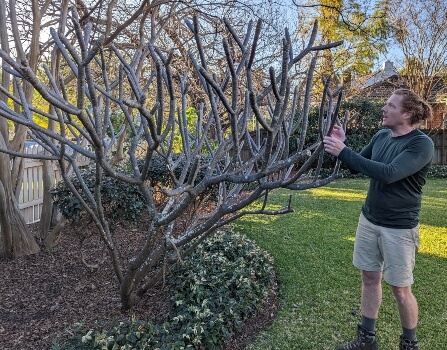
Nathan Schwartz of Aussie Green Thumb beside a dormant Frangipani
What are Frangipanis?
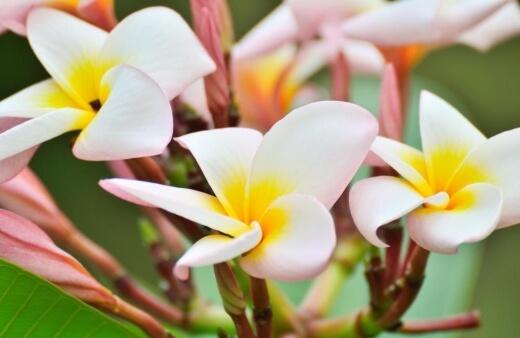
Frangipanis or Plumeria is a flowering genus of the Apocynaceae family. These tropical plants range in size from smaller deciduous shrubs to larger growing trees, reaching as much as 6 metres in height.
The universally revered plants are often recognized by their iconic blooms, which produce a sweet scent throughout the summer.
These blooms come in a range of colours, with some producing bi-coloured or tri-coloured petals. These colours include white, pale pink, butter yellow, red, lilac and crimson.
Frangipanis have a surprisingly small, well-behaved root system which makes them a great option for compact gardens, alongside pools or patios or even pots.
What makes frangipani plants is their somewhat gnarled, swollen looking branches, long green leaves and distinct flowers, which range in colour depending on which cultivar you’re growing.
You might get Plumeria Frangipani and Native Frangipani mixed up. If it is the latter you want to grow then sure to check our complete guide on growing Native Frangipani.
Popular Frangipani Varieties
There is a range of frangipani types, ranging in over 300 different colours. So, when planning which frangipani tree to grow, it’s good to know which colour blooms you can expect in the summer.
Popular Frangipani Varieties
There is a range of frangipani types, ranging in over 300 different colours. So, when planning which frangipani tree to grow, it’s good to know which colour blooms you can expect in the summer.
Plumeria rubra ‘Diva’
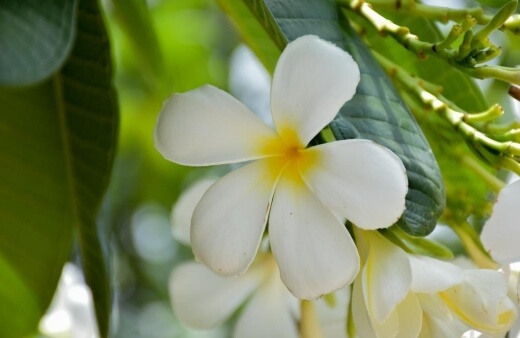
Possibly the most popular variety, producing thick white petals with a yellow centre. It’s a well-known fast grower that thrives in well-draining soil. You will need to ensure plenty of direct sunlight throughout the day.
Plumeria rubra ‘Gabrielle’
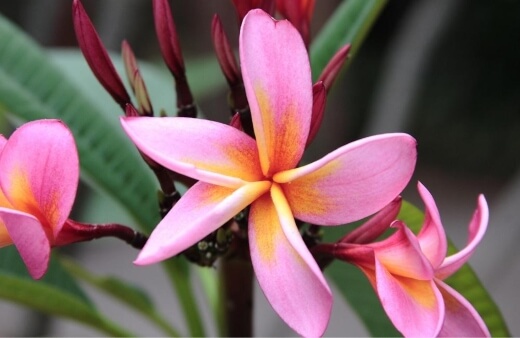
Another popular variety is the ‘Gabrielle. This cultivar produces softer, broad blooms with a yellow centre and pink-tinged tips. They produce a particularly sweet scent. This variety propagates well from a cutting.
Plumeria rubra ‘Vera Cruz Rose’
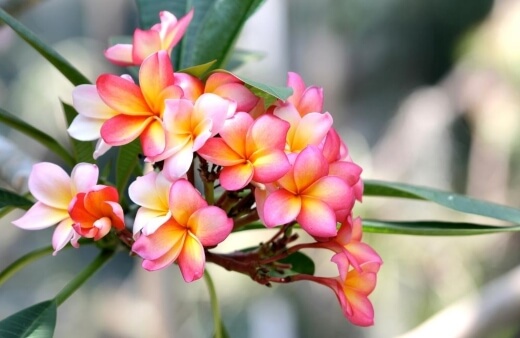
Also known as Lilliana, this variety produces canary yellow leaves with white borders and dark pink bands along with the petals. They emulate the fragrance of red roses. Lilliana is suited for almost any kind of garden.


Get Your Free Guide:
Master Growing Australian Natives eBook
A Must Have Complete Guide for Every Australian Garden
Get Your Free Guide:
Master Growing Australian Natives eBook
A Must Have Complete Guide for Every Australian Garden
Frangipani Darwin Blood Red
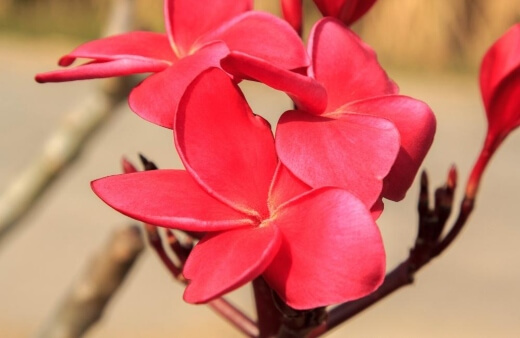
If striking is what you’re after, consider the rich crimson coloured frangipani. While it’s not always available in every store, it definitely will make a lasting impact on your garden.
Frangipani Bali Whirl

Bold and bright yellow, this variety boasts beautifully fragranced blooms. Plus, it produces 10 petals as opposed to the usual 4 or 5.
Plumeria rubra ‘Diva’Possibly the most popular variety, producing thick white petals with a yellow centre. It’s a well-known fast grower that thrives in well-draining soil. You will need to ensure plenty of direct sunlight throughout the day. |  |
|---|---|
Plumeria rubra ‘Gabrielle’Another popular variety is the ‘Gabrielle’. This cultivar produces softer, broad blooms with a yellow centre and pink-tinged tips. They produce a particularly sweet scent. This variety propagates well from a cutting. |  |
Plumeria rubra ‘Vera Cruz Rose’Also known as Lilliana, this variety produces canary yellow leaves with white borders and dark pink bands along with the petals. They emulate the fragrance of red roses. Lilliana is suited for almost any kind of garden. |  |
Frangipani Darwin Blood RedIf striking is what you’re after, consider the rich crimson coloured frangipani. While it’s not always available in every store, it definitely will make a lasting impact on your garden. |  |
Frangipani Bali WhirlBold and bright yellow, this variety boasts beautifully fragranced blooms. Plus, it produces 10 petals as opposed to the usual 4 or 5. |  |
How to Grow Frangipanis
Frangipanis can be planted in pots, along verandas, near windows or beside a pool or water feature. Larger Frangipanis trees also offer a great amount of shade which are wonderful to relax under during the summer.

Nathan Schwartz of Aussie Green Thumb checking the health of a Frangipani tree
Climate
Frangipanis are tropical plants and therefore enjoy a humid environment. They’re ideally suited to coastal areas and places that experience hot summers.
If grown in areas with low humidity, you may need to consider supporting your frangipani with additional humidity, such as through misting.
Sunlight
These plants require plenty of sunlight. Ideally, you’ll want to choose a spot that receives unfiltered sunlight for at least 6 to 8 hours per day.
Soil for Frangipanis
Frangipanis can grow in almost any kind of soil. However, they do tend to prefer loose, sandy soil. This is why they are so well-suited to beachy areas. It’s essential that your soil is well-draining, as frangipanis don’t tolerate wet roots.
Watering
Frangipanis are drought-tolerant, meaning when it comes to water, less is always more. Watering can be done every once in a while and avoided in cold, wet months.
Fertiliser for Frangipani
Fertilising established plants won’t be necessary. However, young plants tolerate occasional fertilisation, and it will help to promote a vibrant bloom year after year. A rose fertiliser is often recommended.
Pruning Frangipanis
Pruning is not always necessary with this species unless it becomes top-heavy. If top-heavy and looking like it’s beginning to droop, you can cut back aggressively without too much worry.
Growing Frangipanis in a Pot
Unless they become overgrown and too large, frangipani plants will grow happily in a pot for a few years. Pots are an especially great option for growing dwarf varieties.
When growing frangipani in pots, it is recommended to use 2/3 potting soil and 1/3 coarse sand. This will ensure your soil drains properly and the roots remain protected.
Be sure that soil is dry to the touch in between watering. When growing frangipani in a pot, it should be avoided to keep your pot in an overly windy spot as you may risk your tree falling over.
Propagating Frangipanis
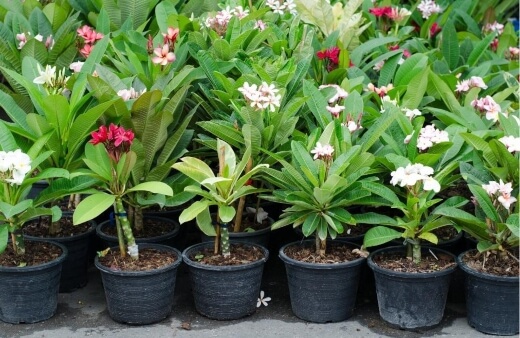
The most common method of propagation is by means of cutting. Cuttings should be taken in late spring. Here is what you’ll need to do:
- Remove a stem cutting from a healthy, thriving plant. Cuttings can be slightly longer.
- Remove any lower leaves and blooms from the stem. Leave only 3 to 4 leaves at the tip of the cutting.
- Leaving it standing upright, allow your cutting to dry out completely and callous for a day or two.
- Insert your cutting into a pot with coarse sand and potting soil to root.
You may need to have some patience and wait until new growth appears before replanting.
Common Frangipani Pests, Problems & Diseases
Although this species is largely resistant, in cold and wet conditions, root or branch rot is a common occurrence. You’ll notice a rot issue if the branches begin to feel soggy to the touch.
A fungicide can be used during the warmer months to help prevent the spread. During the winter, spray the entire tree with a fungicide to prevent an issue in the next growing season.
As a rule of thumb, avoid overwatering your frangipani at all costs. Another important factor to note is that frangipanis produce a milky sap which is slightly toxic to humans.
When this sap comes into contact with the skin, it can cause serious irritation or slight blistering.
Frangipani FAQs

Can frangipani grow indoors?
Ultimately, frangipanis are outdoor plants because they require so much sunlight to bloom. They can, however, be brought indoors for shorter periods of time once they have begun flowering.
Still, it’s recommended to keep these cultivars outdoors for the best results.
How do you take care of frangipani plant in winter?
In regions that experience a colder winter, it may be in your interest to protect your frangipani plant. If growing in a pot, consider keeping your plant in a sheltered, covered spot during the winter.
Why are my frangipani leaves turning yellow?
Frangipani rust can occur in sub-optimal conditions. This rust portrays itself in a thick, yellow powder over the leaves and will restrict the plant’s ability to photosynthesize.
Be sure to remove infected leaves and remove them from your property to avoid spread.
Are Plumeria leaves edible?
There is a lot of online content which advocates for using frangipani flowers in oils and teas to curb certain ailments. However, it is essential to note that the leaves and stems are toxic and should not, by any means, be ingested.
Looking for more tropical plant options? Check out our Cordyline ultimate Australian guide.

Start Growing Frangipani Today!
Once established, be sure to regulate your watering to avoid waterlogged roots. Otherwise, you’ll be able to enjoy a sweetly scented summer garden year after year.
Easy to propagate, easy to grow – you now have everything you need to know to start growing frangipanis in you home.
Published on November 5, 2021 by Gary Clarke
Last Updated on February 21, 2025




